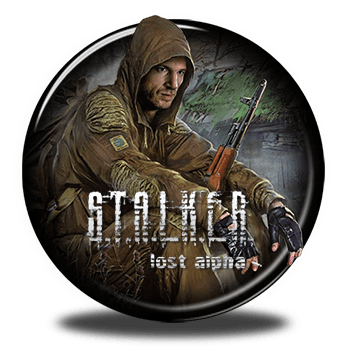Before You Depart
COVID-19 UPDATEDeparting the U.S.: For the safety of everyone in the group, smarTours has implemented COVID-19 travel requirements which apply to all tours regardless of destination. To learn more, click here.
Please note destination entry requirements are changing rapidly. smarTours will communicate entry requirements in your Tour Documents 10-14 days prior to departure. For up-to-date information, please click the links below.
- Entry requirements
- State Department Travel Advisory Updates (United Kingdom, France, Luxembourg, Germany)
- Center for Disease Control Updates & Information (United Kingdom, France, Luxembourg, Germany)
FLIGHT INFORMATION
Your flights from the New York area (Newark) to Europe and back are on the following airlines with the corresponding schedules. We recommend that you arrive at the airport at least 3 ½ hours before the scheduled departure.
| Date | Airline | Newark (EWR) | |
| Depart | Return | ||
| 2022: May 13, Sep. 2 | United Airlines | 7:00 PM | 2:00 PM |
Please make sure to allow sufficient time for clearing immigration and customs if you are planning a connecting flight. We recommend at least 3 ½ hours. Please keep in mind that flight schedules are always subject to change.
ADVANCE SEAT ASSIGNMENT
The above airlines do not assign seats in advance. Please note that smarTours is not involved with your seat assignment. It is between you and the airline! Seat assignments can only be arranged upon check-in at the airport.
LAND-ONLY TRAVELERS
International flights to/from the U.S. are not included. Land-only travelers are responsible for arranging the entry and exit flights, as well as their arrival and departure transfers. smarTours cannot be held responsible for any damage caused by air schedule changes and delays. Unused land services are non-refundable.
Main Tour: Land-only services start upon independent check-in at London hotel on Day 2 of the itinerary listed on our tour page. Land-Only services end after breakfast at Frankfurt hotel on Day 12 of the itinerary listed on our tour page. Land-only travelers forfeit the London sightseeing and lunch on Day 2 as it is en route from the airport to the hotel and will meet the rest of the group during check-in at 4 PM at the hotel.
PASSPORT AND VISA INFORMATION
You must be in possession of a passport valid for at least 6 months after the date of travel. Visa not required for American passport holders. Non U.S. citizens should check with the respective consulates as to the most current visa requirements to all their travel destinations. Please remember that it is your responsibility to obtain the necessary travel documents before the trip.
TICKETS AND FINAL DOCUMENTS
HEALTH REQUIREMENTS
Immunizations are NOT currently required; however, you may wish to visit http://wwwnc.cdc.gov/ travel for current recommendations. As always, we recommend you consult your personal physician or local public health authorities for medical recommendations based on your personal medical history.
CLIMATE
May through October enjoy daytime temperatures in the 60’s and 70’s with the evenings typically cooling off to lows in the 40’s and 50’s. You can expect cooler temperatures November through April with daytime highs in the 40’s and 50’s with evening lows in the 30’s and 40’s. Please keep in mind that there is no distinct wet or dry season. We recommend bringing a waterproof or water-resistant outer layer (jacket, etc).
CREDIT CARDS AND LOCAL CURRENCY
The currency in Great Britain is the pound sterling (£) while the currency in the other visited destinations is the Euro. The best exchange rates can typically be found at the ATM. Hotels and some stores accept major credit cards. However, for “street shopping” you will need local currency. It is recommended that you bring along cash in small denominations.
BAGGAGE
Due to the limitations of both the airlines and the tour buses, each passenger may bring one piece of checked luggage (no more than 50 pounds), and one carry-on piece small enough to fit under the seat in front of you. We recommend that you do not over-pack and that you plan to layer your clothing with climate and comfort in mind.
Jet Engines
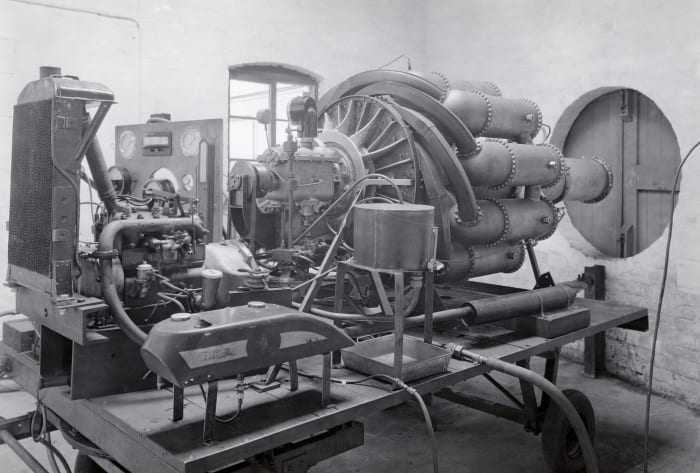
The first jet propulsion engine designed by Frank Whittle, c. 1938. In May 1941 the jet-propelled craft took off from Cranwell in the first real proof that jet propulsion was a viable alternative to the propeller.
Frank Whittle, an English engineer with the Royal Air Force, filed the first patent for the jet engine in 1930. But the first country to fly a jet engine plane was Germany, which performed a flight test of its model on August 27, 1939, just a few days before the country invaded Poland.
“Both Germany and Japan had been really getting ready for World War II for about a decade,” says Rob Wallace, the STEM education specialist at The National WWII Museum in New Orleans.
With the onset of the war, the British government developed planes based on Whittle’s designs. The first Allied plane to use jet propulsion took flight on May 15, 1941. Jet planes could go faster than propeller planes, yet also required a lot more fuel and were more difficult to handle. Though they didn’t have an impact on the war (they were still early in their development), jet engines would later transform both military and civilian transportation.
WATCH: Modern Marvels: Jet Engines on HISTORY Vault
4. Blood Plasma Transfusion
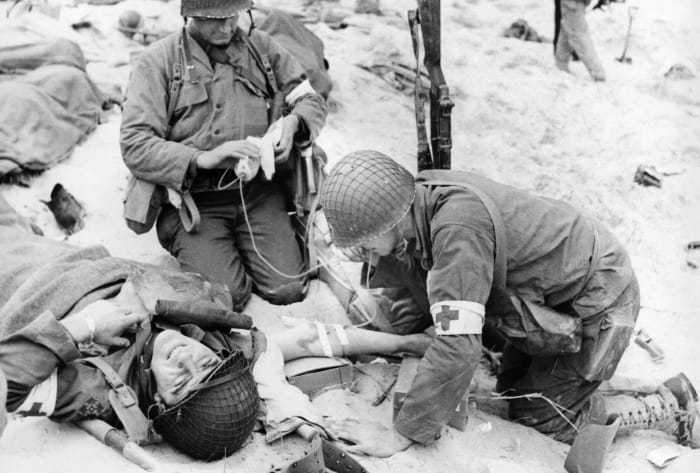
Medics tending to a wounded soldier on D-Day, administer a blood plasma transfusion.
During World War II, a U.S. surgeon named Charles Drew standardized the production of blood plasma for medical use.
“They developed this whole system where they sent two sterile jars, one with water in it and one with freeze-dried blood plasma and they’d mix them together,” Wallace says.
Unlike whole blood, plasma can be given to anyone regardless of a person’s blood type, making it easier to administer on the battlefield.
5. Electronic Computers
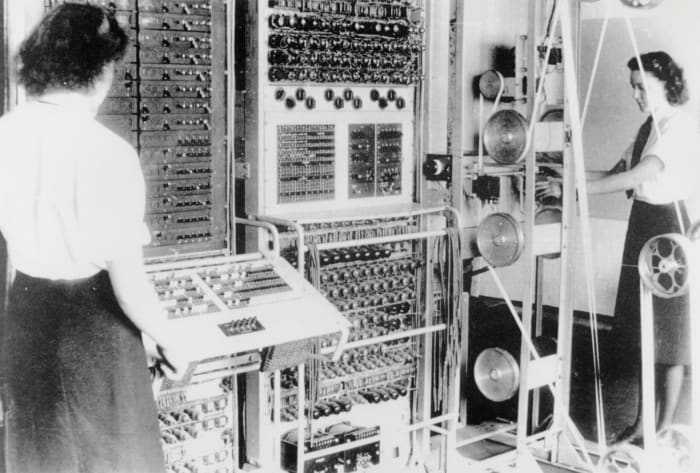
The women seen here belonged to the Women’s Royal Naval Service, (WRNS) October 1943. Colossus was the world’s first electronic programmable computer at Bletchley Park in Buckinghamshire, where cryptographers deciphered top-secret military communiques between Hitler and his armed forces.
In the 1940s, the word “computers” referred to people (mostly women) who performed complex calculations by hand. During World War II, the United States began to develop new machines to do calculations for ballistics trajectories, and those who had been doing computations by hand took jobs programming these machines.
READ MORE: When Computer Coding Was a ‘Woman’s’ Job
The programmers who worked on the University of Pennsylvania’s ENIAC machine included Jean Jennings Bartik, who went on to lead the development of computer storage and memory, and Frances Elizabeth “Betty” Holberton, who went on to create the first software application. Lieutenant Grace Hopper (later a U.S. Navy rear admiral) also programmed the Mark I machine at Harvard University during the war, and went on to develop the first computer programming language.
In Britain, Alan Turing invented an electro-mechanical machine called the Bombe that helped break the German Enigma cipher. While not technically what we’d now call a “computer,” the Bombe was a forerunner to the Colossus machines, a series of British electronic computers. During the war, programmers like Dorothy Du Boisson and Elsie Booker used the Colossus machines to break messages encrypted with the German Lorenz cipher.
6. Radar
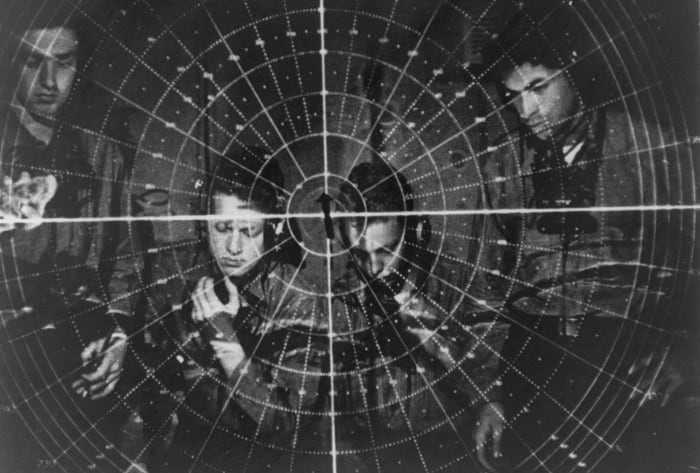
Personnel manning a radar scope during World War II.
The first practical radar system was produced in 1935 by British physicist Sir Robert Watson-Watt, and by 1939 England had built a network of radar stations along its south and east coasts. MIT’s Radiation Laboratory, or “Rad Lab,” played a huge role in advancing radar technology in the 1940s. However, the lab’s original goal was to use electromagnetic radiation as a weapon, not a form of detection.
“Their first idea that they had was that if we could send a beam of electromagnetic energy at a plane, maybe we could kill the pilot by cooking them or something,” Wallace says. “The cooking thing wasn’t working, but they were getting bounce-back that they could receive and they had the idea that they could use electromagnetic radiation just like they used sound radiation in sonar. So they started working on radar.”
The spread of war
Soon, the conflict had expanded to the world, affecting colonies and ally countries in Africa, Asia, the Middle East, and Australia. In 1917, the United States entered the war after a long period of non-intervention. By then, the main theater of the war—the Western Front in Luxembourg, the Netherlands, Belgium, and France—was the site of a deadly stalemate.
Despite advances like the use of poison gas and armored tanks, both sides were trapped in trench warfare that claimed enormous numbers of casualties. Battles like the Battle of Verdun and the First Battle of the Somme are among the deadliest in the history of human conflict.
Aided by the United States, the Allies finally broke through with the Hundred Days Offensive, leading to the military defeat of Germany. The war officially ended at 11:11 a.m. on November 11, 1918.
By then, the world was in the grips of an influenza pandemic that would infect a third of the global population. Revolution had broken out in Germany, Russia, and other countries. Much of Europe was in ruins. “Shell shock” and the aftereffects of gas poisoning would claim thousands more lives.
Radar

Personnel manning a radar scope during World War II.
The first practical radar system was produced in 1935 by British physicist Sir Robert Watson-Watt, and by 1939 England had built a network of radar stations along its south and east coasts. MIT’s Radiation Laboratory, or “Rad Lab,” played a huge role in advancing radar technology in the 1940s. However, the lab’s original goal was to use electromagnetic radiation as a weapon, not a form of detection.
“Their first idea that they had was that if we could send a beam of electromagnetic energy at a plane, maybe we could kill the pilot by cooking them or something,” Wallace says. “The cooking thing wasn’t working, but they were getting bounce-back that they could receive and they had the idea that they could use electromagnetic radiation just like they used sound radiation in sonar. So they started working on radar.”
Radar helped the Allied forces detect enemy ships and planes. Later, it proved to have many non-military uses, including guiding civilian crafts and detecting major weather events like hurricanes.
Penicillin
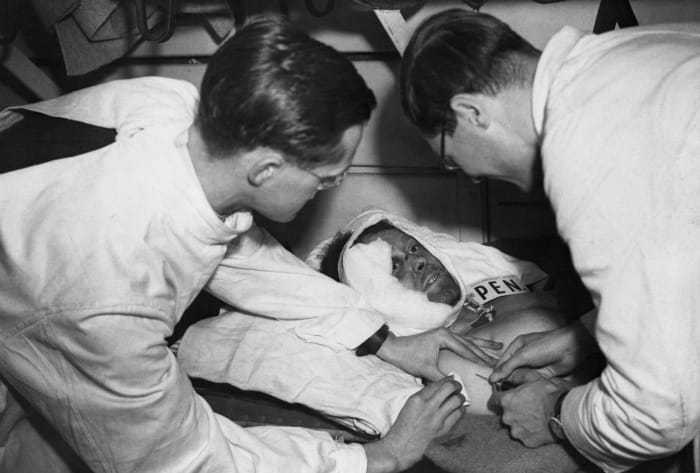
Injured British Pvt. F. Harris waits for a medic to inject penicillin in preparation for an operation on a hospital train on its way to a station in England. Harris was wounded during an attack on a position in Normandy.
Before the widespread use of antibiotics like penicillin in the United States, even small cuts and scrapes could lead to deadly infections. The Scottish scientist Alexander Fleming discovered penicillin in 1928, but it wasn’t until World War II that the United States began to mass-produce it as a medical treatment.
Manufacturing penicillin for soldiers was a major priority for the U.S. War Department, which touted the effort as “a race against death” in one poster. Military surgeons were amazed by how the drug reduced pain, increased the chance of survival and made it easier for nurses and doctors to care for soldiers on the battlefield.
The United States considered the drug so critical to the war effort that, to prepare for the D-Day landings, the country produced 2.3 million doses of penicillin for the Allied troops. After the war, civilians gained access to this life-saving drug, too.
WATCH: D-Day: The Untold Stories on HISTORY Vault
Flu Vaccines
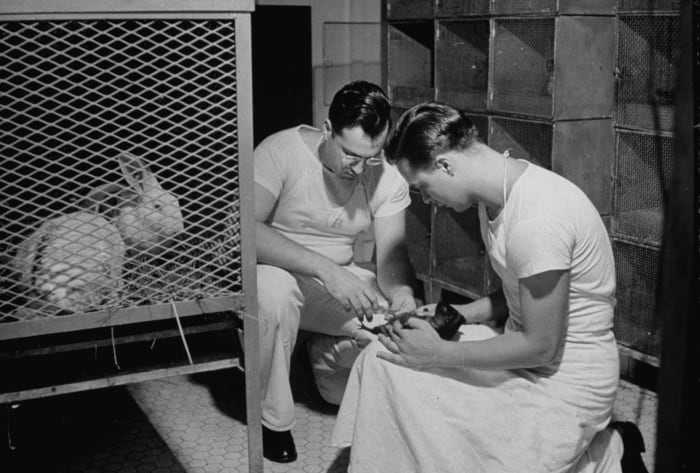
A guinea pig being inoculated to determine type of pneumonia and aid in diagnosis of other infectious diseases on the U.S.S. Solace, Navy Hospital Ship, c. 1942.
The influenza pandemic of 1918 and 1919 had a major effect on World War I, and it motivated the U.S. military to develop the first flu vaccine. Scientists began to isolate flu viruses in the 1930s, and in the 1940s, the U.S. Army helped sponsor the development of a vaccine against them.
The U.S. approved the first flu vaccine for military use in 1945 and for civilian use in 1946. One of the lead researchers on the project was Jonas Salk, the U.S. scientist who would later develop the polio vaccine.
Pandemics: Full Coverage
Electronic Computers

The women seen here belonged to the Women’s Royal Naval Service, (WRNS) October 1943. Colossus was the world’s first electronic programmable computer at Bletchley Park in Buckinghamshire, where cryptographers deciphered top-secret military communiques between Hitler and his armed forces.
In the 1940s, the word “computers” referred to people (mostly women) who performed complex calculations by hand. During World War II, the United States began to develop new machines to do calculations for ballistics trajectories, and those who had been doing computations by hand took jobs programming these machines.
READ MORE: When Computer Coding Was a ‘Woman’s’ Job
The programmers who worked on the University of Pennsylvania’s ENIAC machine included Jean Jennings Bartik, who went on to lead the development of computer storage and memory, and Frances Elizabeth “Betty” Holberton, who went on to create the first software application. Lieutenant Grace Hopper (later a U.S. Navy rear admiral) also programmed the Mark I machine at Harvard University during the war, and went on to develop the first computer programming language.
In Britain, Alan Turing invented an electro-mechanical machine called the Bombe that helped break the German Enigma cipher. While not technically what we’d now call a “computer,” the Bombe was a forerunner to the Colossus machines, a series of British electronic computers. During the war, programmers like Dorothy Du Boisson and Elsie Booker used the Colossus machines to break messages encrypted with the German Lorenz cipher.
BATTLEFIELDS OF WWI & WWII
Are you a history buff? Do you enjoy traveling to iconic sites of the past? If so, you’re going to love our new trip that takes you on a tour of World War I and World War II battlefields across Europe. You’ll discover the places that commemorate these world-changing events and honor fallen soldiers. This tour includes a journey through London to visit the Imperial War Museum and Churchill War Rooms. You’ll also visit Normandy Beach, Somme & Ypres Battlefields, Dunkirk, Battle of the Bulge and the Maginot Lines.
Extend Your Trip! Enjoy our 15-day Battlefields of WWI & WWII with Berlin tour visiting highlights from London to Berlin.
For COVID-19 updates, please scroll down to our section.
Causes of the Great War
World War I had a variety of causes, but its roots were in a complex web of alliances between European powers. At its core was mistrust between—and militarization in—the informal “Triple Entente” (Great Britain, France, and Russia) and the secret “Triple Alliance” (Germany, the Austro-Hungarian Empire, and Italy).
The most powerful players, Great Britain, Russia, and Germany, presided over worldwide colonial empires they wanted to expand and protect. Over the course of the 19th century, they consolidated their power and protected themselves by forging alliances with other European powers.
In July 1914, tensions between the Triple Entente (also known as the Allies) and the Triple Alliance (also known as the Central Powers) ignited with the assassination of Archduke Franz Ferdinand, heir to the throne of Austria-Hungary, by a Bosnian Serb nationalist during a visit to Sarajevo. Austria-Hungary blamed Serbia for the attack. Russia backed its ally, Serbia. When Austria-Serbia declared war on Serbia a month later, their allies jumped in and the continent was at war.
